
- Topics 1533
- Industrial 59
- Troubleshooting Guides 31
- Restaurant Management 140
- Bar Management 66
- Catering Tips 38
- Bakery Management 47
- Food Trucks & Concessions 49
- Advertising & Marketing 40
- Eco-Friendly Tips 12
- Facility Layout & Design 50
- Coffee Shop Tips 32
- Installation & Maintenance 59
- Janitorial & Pest Control 33
- Safety & Sanitation 108
- Startup Tips 113
- Menu Design 11
- Kitchen & Cooking Tips 103
- Hospitality Management 25
- Pizza & Sandwich Shop Tips 31
- Smallwares 40
- Food Prep 101
- Tabletop Items 19
- Disposables 26
- Calculators & Tools 8
- Consumables 70
- Warewashing & Laundry 21
- Cooking Equipment 103
- Food Storage & Refrigeration 54
- Beverage Equipment 39
- Office Supplies 5
Condiment containers are designed to hold a variety of condiments, sauces, and toppings, providing convenience and efficiency in food preparation and service. From ketchup and mustard to salad dressings and salsa, condiment containers play a crucial role in enhancing the dining experience for customers. There are a wide variety of condiment containers available, each made with different materials and offering unique benefits in terms of durability, visibility, and ease of cleaning. Below we delve deeper into the different types of condiment containers, their uses, and the best practices for maintaining their hygiene and organization in your commercial establishment.
Shop All Condiment Holders and Dispensers
When purchasing condiment containers for your commercial foodservice establishment, there are several important factors to consider to ensure you choose the right containers that meet your specific needs. Here are some key points to keep in mind:
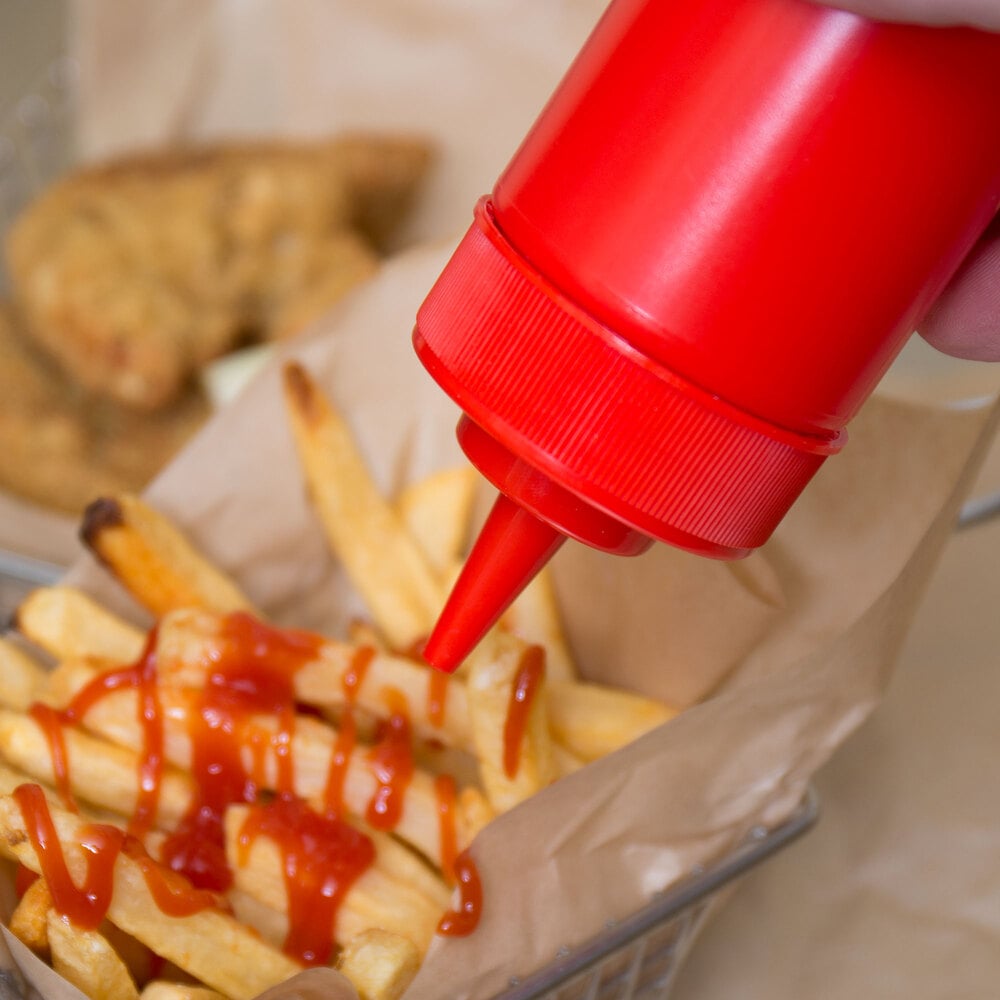
- Type of Condiment - The first consideration when purchasing a condiment container is the type of condiment you need to contain. Whether it's ranch, hot sauce, or any other condiment, it's essential to choose a container that is suitable for the specific condiment you will be serving.
- Form of Condiment - Consider the form in which the condiment is typically stored. Is it in bulk quantities, individual packets, squeeze bottles, or another form? This will help you determine the type of container that is most practical for dispensing and storing the condiment.
- Purpose of the Container - Determine whether the container will be used for serving, storing, or both. Some condiment containers are designed specifically for serving at tables or self-serve stations, while others are better suited for storage in refrigerators or pantries.
- Serving and Storage Locations - Think about where the condiment container will be served and/or stored in your establishment. Will it be placed on dining tables, countertops, condiment stations, or in the kitchen? This will influence the size, shape, and design of the container you choose.
- Portion Size - Consider how many portions of the condiment the container needs to hold at a time. If you serve high volumes of customers or need to refill the container frequently, you may want to opt for larger capacity containers to minimize the need for constant refilling.
There are many different ways that you can think of condiment containers, from what specific condiment they're designed for to how much they hold. Remember that the needs of your kitchen and menu dictate how you should approach determining and selecting what condiment containers are right for you.
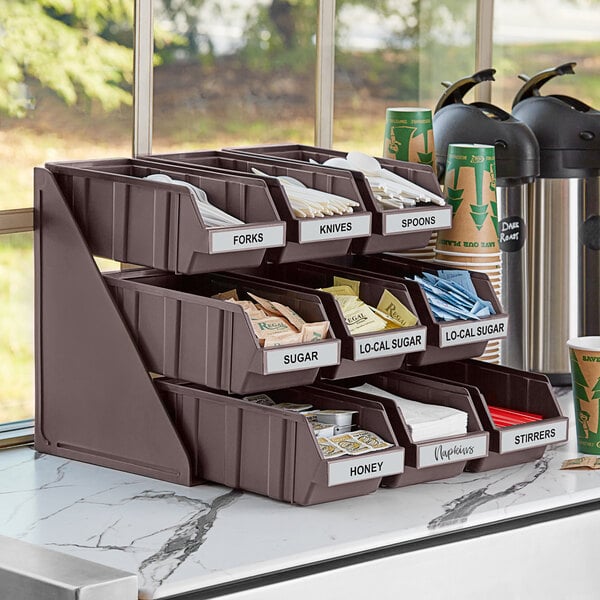
- Size - Condiment containers come in a range of sizes to accommodate different quantities of condiments. From small individual portion cups to larger bulk containers, there is a size suitable for every application. The size of the container should be selected based on the volume of condiments that need to be stored or dispensed.
- Material - Regardless of the condiment and what you want to do with it, you'll need to decide what you expect from the container's material. Some materials clean easier than others, and some are more durable than others. Determine the most important quality of the material you want. That information will help you to narrow down your options.
- Versatility - Some containers, like ramekins or jars, are incredibly versatile and can be used for various condiments, toppings, or even small food items. On the other hand, there are containers that serve a more specific function extremely efficiently, such as butter dishes. Investing in versatile condiment containers is a smart choice for any commercial kitchen, allowing you to reuse your investment in countless ways.
- Use - Condiment containers typically fall into two main subcategories: holders and dispensers. Holders are designed primarily for storage purposes and provide a place to store condiments such as mustard or salad dressings. Dispensers, on the other hand, are designed to streamline the process of accessing and serving condiments. These containers feature mechanisms that allow for controlled dispensing of condiments.
Condiment holders for packaged foods are essential for any commercial foodservice operation that offers grab-and-go options or pre-packaged meals. These holders provide a convenient and organized way to display and dispense condiments such as ketchup, mustard, and mayonnaise alongside your pre-packaged foods.
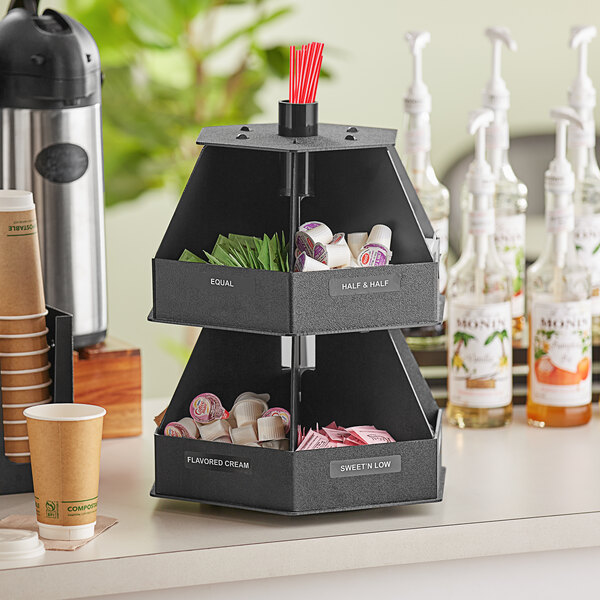
Condiment Organizer
A condiment organizer is a versatile solution for storing and dispensing a variety of condiments in one convenient unit. These organizers typically feature multiple compartments that can hold different condiments such as barbecue sauce and ranch, making it easy for customers to access their favorite toppings.
- Common Materials - Bamboo, metal, plastic
- Usage - Countertops, beverage stations
- Benefits - Accommodates a selection of condiments in an organized manner, space-efficient design, easy to refill and access
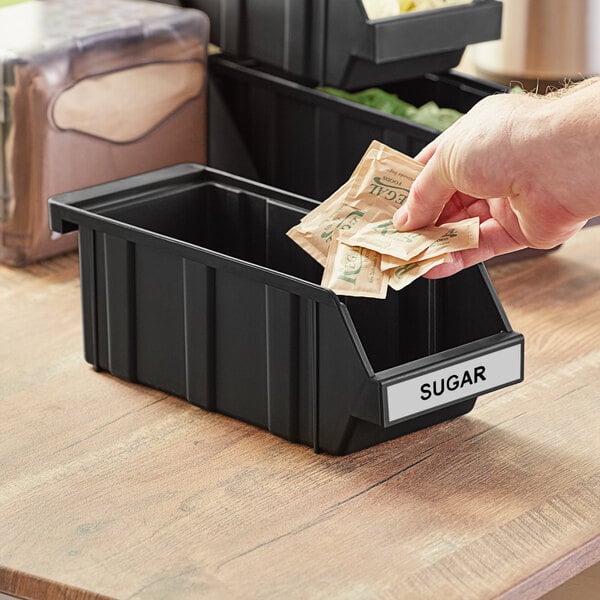
Condiment Bin
Condiment bins are ideal for holding larger quantities of condiments. These bins usually have a larger capacity and are designed to be easily refilled as needed, making them a practical choice for high-traffic food service establishments.
- Common Materials - Bamboo, metal, plastic
- Usage - Countertops, beverage stations
- Benefits - Its versatile design holds condiments or supplies like flatware and straws, easy to refill and access
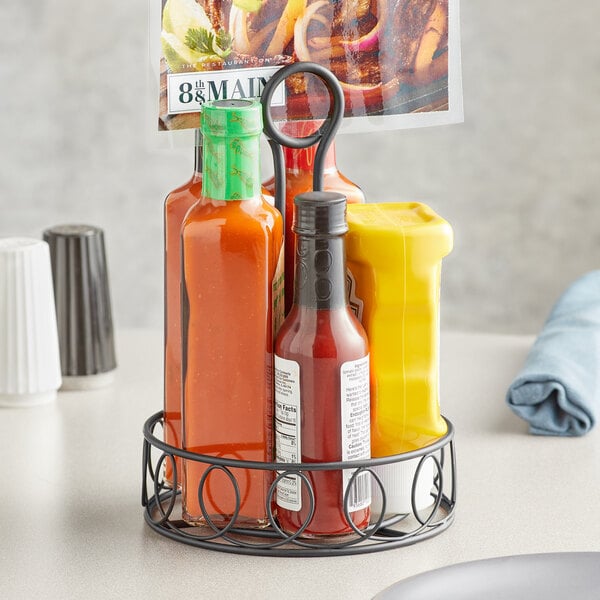
Condiment Caddy
A condiment caddy is a compact and portable option for holding individual condiment packets or small bottles. These caddies are perfect for tabletop use or self-service stations where customers can grab their desired condiments conveniently.
- Common Materials - Chrome wire, galvanized metal, metal, polyethylene, stainless steel, tin
- Usage - Individual tables
- Benefits - Organizes a selection for limited use, can hold a variety of packaged condiments, promotes variety, not quantity
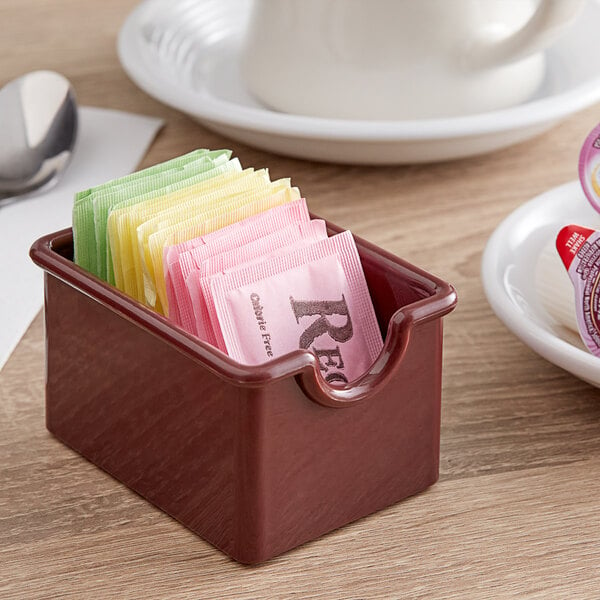
Sugar Caddy
While primarily used for sugar packets, sugar caddies can also be repurposed to hold other condiments like salt and pepper packets. These caddies help keep tabletops clutter-free and provide a neat presentation for customers to enhance their dining experience.
- Common Materials - Bone china, ceramic, china, galvanized metal, glass, metal, plastic, porcelain, SAN plastic, stainless steel
- Usage - Individual tables
- Benefits - Perfect for offering a few different types of sweeteners, easy to refill and access, small in size and footprint
Condiment holders for unpackaged food offer practical and aesthetically pleasing storage solutions that enhance the efficiency and presentation of condiments. These holders make it easy to store and present condiments like relish and dressing for easy use.
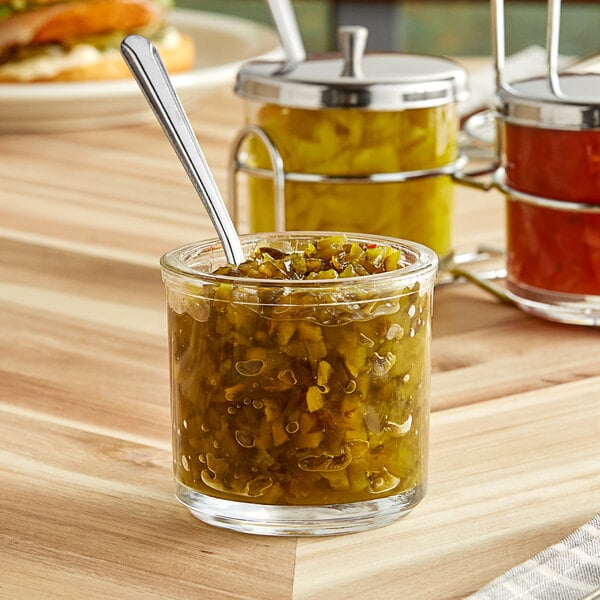
Condiment Jars
Condiment jars are a popular choice for storing a wide range of bulk condiments such as ketchup, mustard, mayonnaise, and relish. Their clear glass or plastic construction allows for easy visibility of the contents, making it simple for customers to identify and access their desired condiment.
- Common Materials - Acrylic, glass, melamine, metal, plastic, porcelain, stainless steel, wood
- Usage - Kitchens, bars, buffets, self-serve stations
- Benefits - When used with a lid, it can store food overnight, great for display, decor, or aesthetic kitchen storage, holds a wide variety of bulk foods
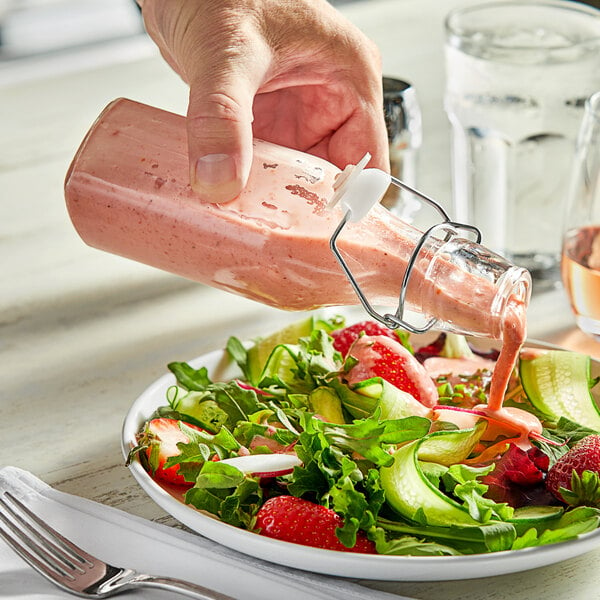
Milk Bottles
Milk bottles are another classic option for holding condiments like creamer, milk, or flavored syrups. Their charming design adds a nostalgic touch to any tabletop setting, enhancing the overall dining experience for customers.
- Common Materials - Glass
- Usage - Served to individual customers or tables, buffets
- Benefits - Great for display or decor, adds style to serving, holds a variety of foods, can be used to serve beverages
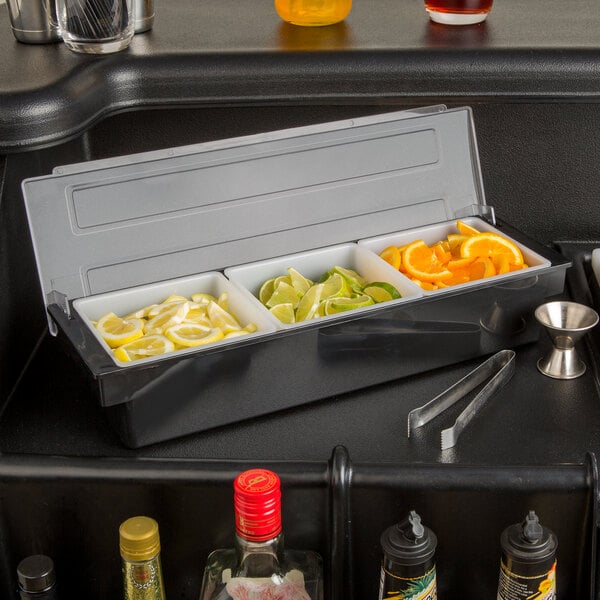
Countertop Condiment Holder
Countertop condiment holders are versatile storage solutions that can accommodate various condiments in one convenient place. These holders often feature multiple compartments or slots, allowing for organized storage of items like fruit garnishes, sauces, and relishes.
- Common Materials - Glass, plastic, stainless steel, wire, wood
- Usage - Countertops, kitchens, salad / sandwich / ice cream bars
- Benefits - Efficiently uses counter space, holds a wide variety of foods, available with different numbers of compartments
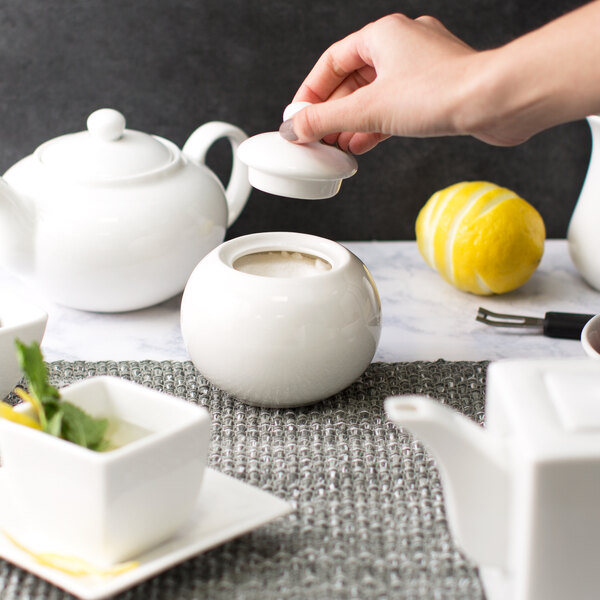
Sugar Bowls
Sugar bowls are key for keeping sugar readily available for coffee, tea, and other beverages. These bowls typically have a lid to protect the sugar from contaminants while ensuring easy access for customers.
- Common Materials - Porcelain, stainless steel
- Usage - Individual tables, with tea orders, upscale events
- Benefits - Allows you to buy economical, bulk sweeteners, stores food overnight, easy to refill and access, available in sets with a container for creamer for hot beverage purposes
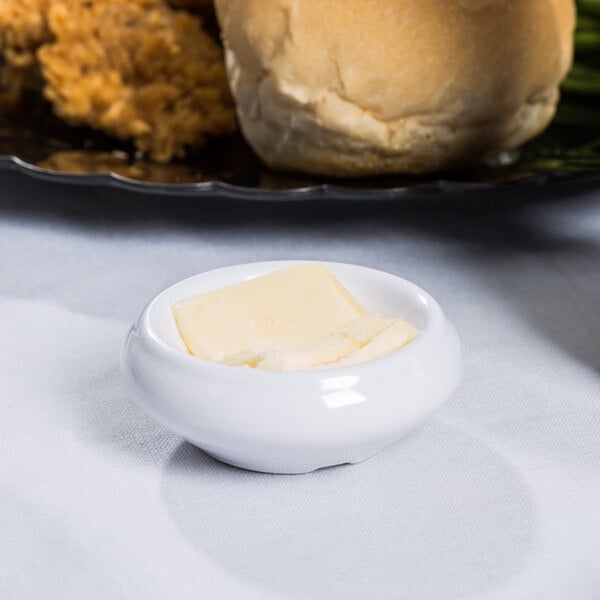
Butter Dishes
Butter dishes are perfect for holding individual servings of butter or spreads, keeping them fresh and easily accessible for customers. Their durable construction helps maintain the quality of the condiment throughout service.
- Common Materials - Melamine, porcelain
- Usage - Individual tables
- Benefits - Stores and serves butter, perfect for serving with bread, depending on the design, can hold an entire stick of butter or margarine, round dishes accommodate butter as well as other spreads
Condiment dispensers are necessary for topping foods and drinks. These are designed to easily distribute condiments, making it easy for customers to get exactly the amount of topping they want.
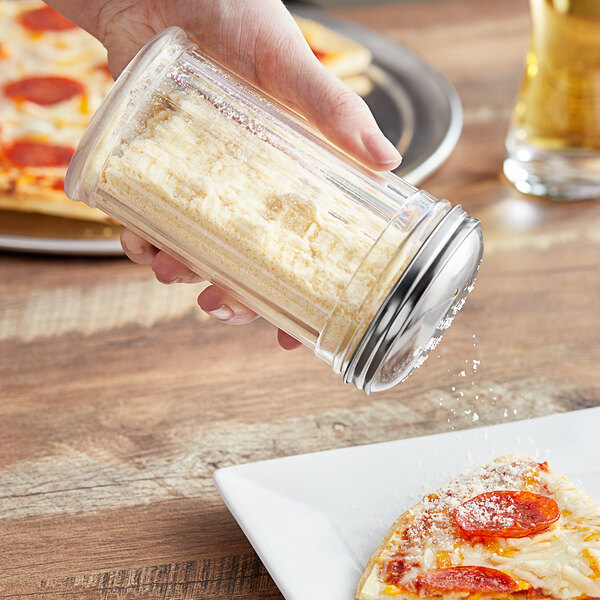
Shakers
Shakers are a popular choice for dispensing dry condiments such as salt, pepper, sugar, and cheese. They typically feature perforated tops that allow for controlled sprinkling, making them ideal for tabletop use in restaurants.
- Common Materials - Aluminum, glass, plastic, stainless steel
- Usage - Kitchens, individual tables, salad / sandwich / ice cream bars
- Benefits - Perfect to use when adding a limited amount of ingredient to a dish, easy to use, allows you to economically buy in bulk
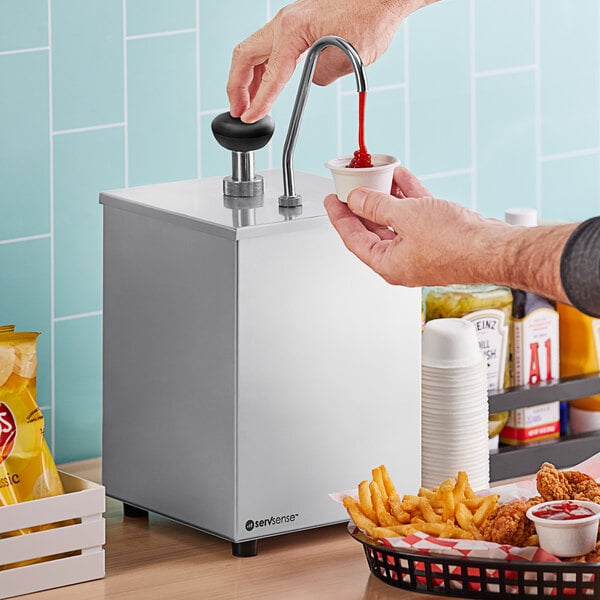
Pump Dispensers
Pump dispensers are commonly used for liquid condiments like ketchup, mustard, and salad dressings. These dispensers provide portion control and reduce mess, making them a convenient option for self-serve stations or salad bars.
- Common Materials - Plastic, stainless steel
- Usage - Countertops, salad / sandwich / ice cream bars, buffets, kitchens
- Benefits - Easy to use, low-mess, comes with a variety of compartments to offer condiment variety, quick service
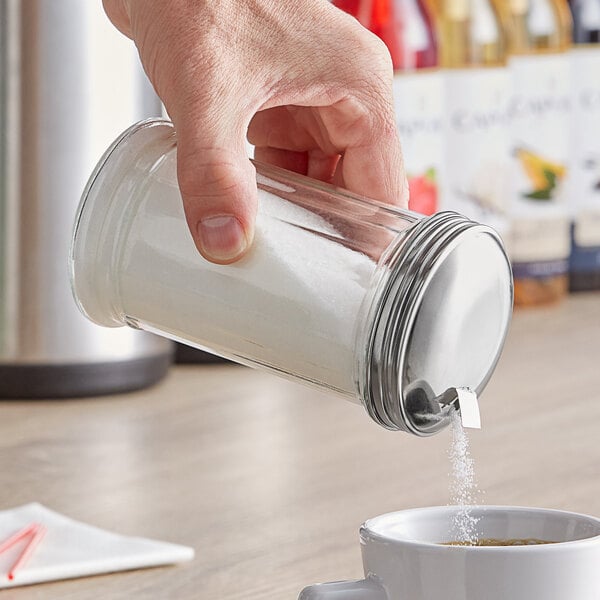
Pourers
Pourers are designed for condiments like sugar and salt, offering a controlled pour for precision in food preparation. These dispensers are often used in commercial kitchens and tabletops for seasoning and salting dishes.
- Common Materials - Glass, plastic
- Usage - Kitchens, individual tables, beverage stations
- Benefits - Allows you to economically buy in bulk, pours a lot or a little
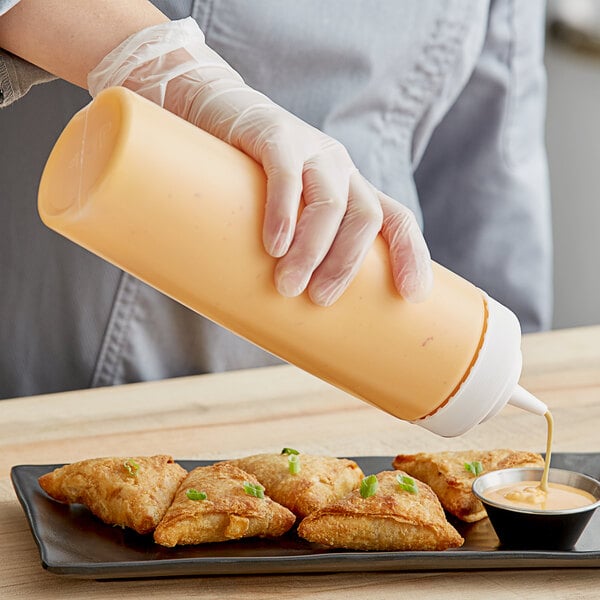
Squeeze Bottles
Squeeze bottles are pliable, cylindrical containers that dispense liquids, such as sauces and dips, from the top spout when squeezed. Their easy-to-use design makes them a popular choice for fast-paced foodservice environments.
- Common Materials - Plastic, polyethylene
- Usage - Kitchens, countertops, individual tables, buffets, food trucks, salad / sandwich / ice cream bar
- Benefits - Easy to use, won't spill, accommodates a variety of liquid foods

Gravy Boats
Gravy boats are easy-to-pour open containers, usually with a handle on one end, designed to serve and pour sauces and gravies.
- Common Materials - Bone china, china, glass, porcelain, stainless steel
- Usage - Individual tables, buffets
- Benefits - Easy to fill and use, accommodates multiple different foods, holds several servings of sauce, gravy, dressing, or other toppings
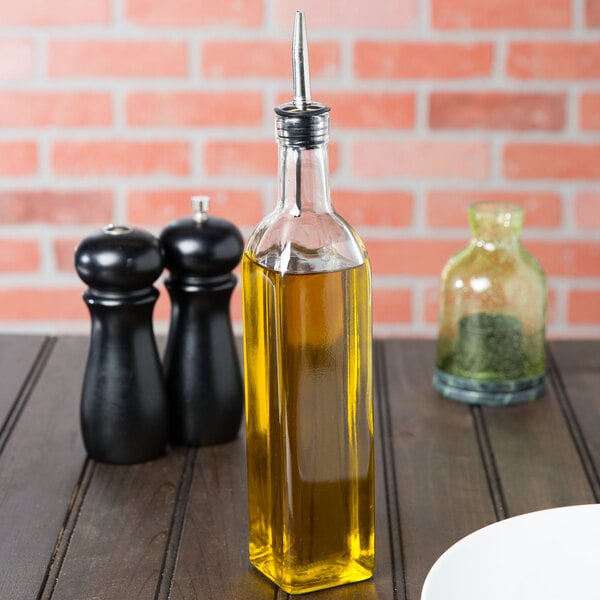
Cruets
Cruets are tall containers used to store and serve oil or different types of vinegar. When cruets are not used with a lid, they are typically used with a pourer.
- Common Materials - Glass, stainless steel
- Usage - Individual tables, buffets, salad / sandwich / ice cream bars, kitchens
- Benefits - Small spout makes pouring easy, adds decorative touch to commonly used ingredients, used for vinegar and oil

Mills
Mills are specialized dispensers for condiments like salt and pepper, offering freshly ground seasonings for enhanced flavor. Often a cylindrical container that houses salt and/or pepper, and then when twisted, dispenses it.
- Common Materials - Acrylic, stainless steel, wood
- Usage - Individual tables, served at the table, kitchens
- Benefits - Easily twists to grind salt or pepper and dispense, small footprint, decorative, allows you to serve freshly ground salt or pepper
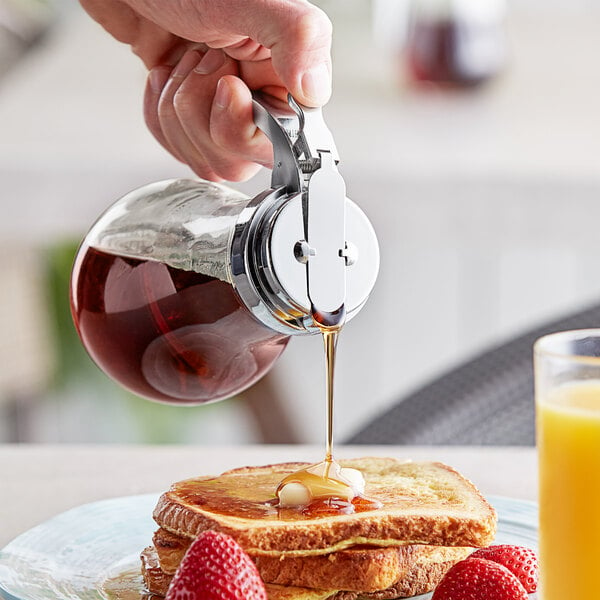
Syrup Dispensers
Syrup dispensers are designed specifically for dispensing syrups like maple or chocolate, making them a must-have for breakfast or dessert establishments looking to add flavor to dishes.
- Common Materials - Glass, polycarbonate, polyethylene
- Usage - Kitchens, individual tables
- Benefits - Efficient way to dispense slow-moving syrup, easy to refill and use
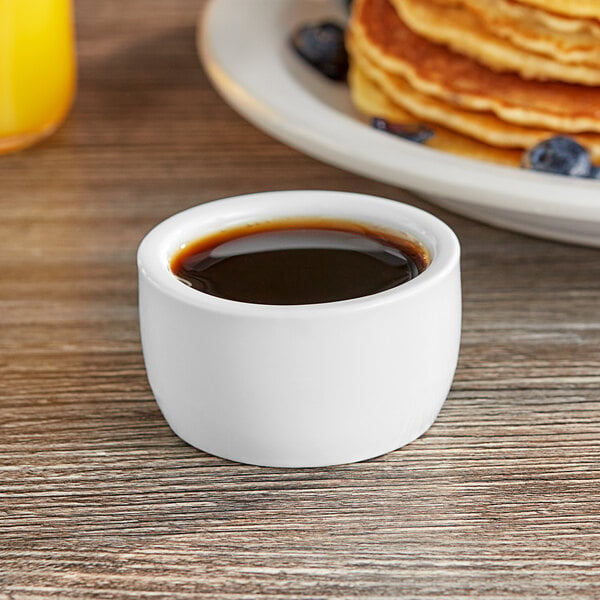
Ramekins and Sauce Cups
Ramekins and sauce cups are small containers used for serving individual portions of condiments like dipping sauces, salsa, or aioli. These versatile containers are perfect for presenting condiments alongside appetizers or main dishes.
- Common Materials - China, cast aluminum, glass, plastic, melamine, stainless steel
- Usage - Individual tables, kitchens, condiment stations
- Benefits - Very versatile, easy to fill and access, perfect for dipping, holds single serving, decorative
When buying condiment containers, pay attention to the material. For instance, glass may be stylish, but it breaks easily, and breakage can dramatically increase cost over time. When selecting a material, consider not just appearance, but durability, longevity, and cleanability. Look through the chart below to learn about a few common material options available.
These containers are made from a durable and transparent plastic material that allows for easy visibility of the contents inside.
- Shatterproof
- Mimics appearance of glass
- BPA-Free
- Tends to crack, which can lead to leakage
- Tends to spot and chip
- Not dishwasher or microwave safe
Bamboo dispensers and holders are crafted from sustainable bamboo, making them a durable and environmentally conscious choice for your commercial establishment.
- Economical and trendy
- Environmentally friendly
- Resistant to heat, stains, and water
- Excessive moisture can lead to molding
- Prone to scratches
- Not recommended for use in dishwasher
Cast aluminum condiment dispensers are a popular choice in commercial foodservice establishments due to their durability and sleek appearance. They are easy to clean and versatile, allowing them to fit into a variety of commercial applications.
- Resistant to corrosion
- Light weight and durable
- Attractive, sleek appearance
- Not recommended for use in dishwasher
- Tends to stain
- Cast aluminum is heavier than other materials
Ceramic condiment dispensers and holders offer both practical functionality and aesthetic appeal to a dining setting.
- Stain- and odor-resistant
- Leak-proof
- Tends to retain finish
- Handles cold and heat well
- Fragile
- May not be dishwasher or microwave safe
- Some models may not be suitable for acidic or corrosive condiments
- Tend to be more expensive than plastic or glass options
These dispensers are commonly used in restaurants, cafeterias, and catering businesses to offer an elegant and stylish way to present a variety of condiments to customers.
- Elegant
- Leak-proof
- Wide variety of colors and patterns available
- Fragile
- May not be dishwasher or microwave safe
- Tend to be more expensive upfront
Galvanized metal holders and dispensers are perfect for establishments looking for a durable and rustic option to store and dispense condiments.
- Durable
- Leak-proof
- Trendy, rustic appearance
- Metal containers can conduct heat, so it's essential to be cautious when handling hot condiments
- Not completely immune to dents or scratches
- Difficult to clean
These condiment containers are elegant and stylish while also offering customers near-total visibility of the contents inside.
- Elegant or Casual
- Provides excellent food visibility
- Fragile
- Breakage creates sharp, dangerous fragments
These containers are made from melamine, a type of durable plastic that is resistant to breakage, chipping, and scratching.
- Similar to china or porcelain in appearance
- Break- and shatter-resistant
- Durable
- Not microwave safe
- When heated, can leach toxins into food
- Prone to scratching
*This is a common, unspecific material name. Usually it refers to "polyethylene," which is how it's used here. Take note, however, that it can refer to SAN plastic, HDPE, and polycarbonate, among other plastics. Find a few of these other plastics described separately in the table, as they may be directly identified as a container's material.
- Durable
- Economical
- Inexpensive
- Easy to clean
- Not always microwave and dishwasher safe
- White plastic can discolor
- Brittle when cold
- Not commonly perceived as stylish
Polycarbonate condiment holders and dispensers are versatile and durable options for storing and serving a variety of condiments in commercial foodservice settings. Made from a type of plastic known for its strength and clarity, polycarbonate condiment holders offer several advantages for businesses looking to enhance their condiment presentation and organization.
- Durable
- Economical
- Mimics appearance of glass
- Low scratch resistance
- Contains BPA
- May not be dishwasher or microwave safe
Porcelain containers are not only aesthetically pleasing, but also offer a range of benefits operators can enjoy when storing and serving condiments.
- Elegant
- More durable than china or bone china
- Tends to chip and break
- Not recommended for use in dishwasher or microwave
SAN, or Styrene Acrylonitrile, is a durable and food-safe material that is commonly used for foodservice products. SAN plastic condiment holders and dispensers offer several advantages, making them a versatile option for restaurants, cafes, and other food establishments.
- Durable
- BPA-Free
- Economical
- Resistant to boiling water
- May wear with regular use in dishwasher
- Not recommended for extended use in microwave
- Limited insulation for temperature-sensitive condiments
- Prone to scratching
These containers offer a sleek and professional appearance that can enhance the presentation of condiments on tabletops, buffet stations, or self-serve areas.
- Durable
- Corrosion-resistant
- Long-lasting
- Sleek, trendy appearance
- Tends to scratch
- Higher cost
- Prone to showing fingerprints and smudges
- Generally heavier than plastic or glass counterparts
Tin condiment holders are durable and easy to clean, making them a practical option for busy establishments.
- Light weight
- Trendy, rustic appearance
- Durable
- Corrosion-resistant to common chemicals
- Can corrode aluminum and other bare metals
- Poor corrosion-resistance to certain paints
- Tends to stain and tarnish
- Difficult to clean
Wood condiment holders are a popular choice for businesses looking to add a touch of rustic charm to their tabletop presentation. These products are typically made from high-quality wood materials such as bamboo or acacia, offering a natural and eco-friendly option for serving condiments.
- Trendy
- Environmentally friendly
- Difficult to clean
- Not NSF approved
Related Resources

December 2025 WebstaurantStore Coupon Code
The holiday season is here, and during December you can find amazing deals on important items here at WebstaurantStore for the upcoming season. We're offering great sales all month long, with deals ranging from essential restaurant beverage equipment to themed take-out supplies for your festive creations. Check out our selection of sale items below and don't forget to enter the code WINTER25 at checkout to enjoy savings of up to 10%! Looking to save even more? Check out the new Webstaurant Rewards® Visa Business Card ! Sign up for a new card today and start earning rewards on every WebstaurantStore purchase, and save on a WebstaurantPlus subscription. Explore incredible deals on festive disposable items with December's monthly coupon code!

What's the Big Deal About BPA?
Whether you're ordering new plastic containers for your restaurant kitchen or a new water bottle for personal use, you've probably seen products that brag, "BPA Free!" But what is BPA, and is it necessary to avoid it? BPA is short for Bisphenol A, a chemical that's been used to make polycarbonate plastics and resins since the 1950s. The chemical started to get attention in the 1990s when customers began to ask, "Is BPA safe?" Since then, there have been several studies that have attempted to link BPA to health problems, but the FDA has concluded that a low level of BPA exposure is not harmful to humans. Despite this, the U.S. and Canada have banned baby bottles with BPA to prevent potentially negative effects in children, and many companies
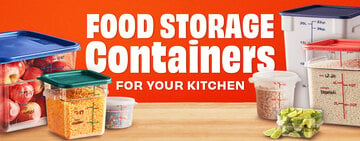
Types of Food Storage Containers
Food storage containers are essential to any commercial kitchen. There are different shapes, sizes, and materials, each with its own special function. Knowing which container to use for each of your food items is important for you to have a well-organized kitchen.

